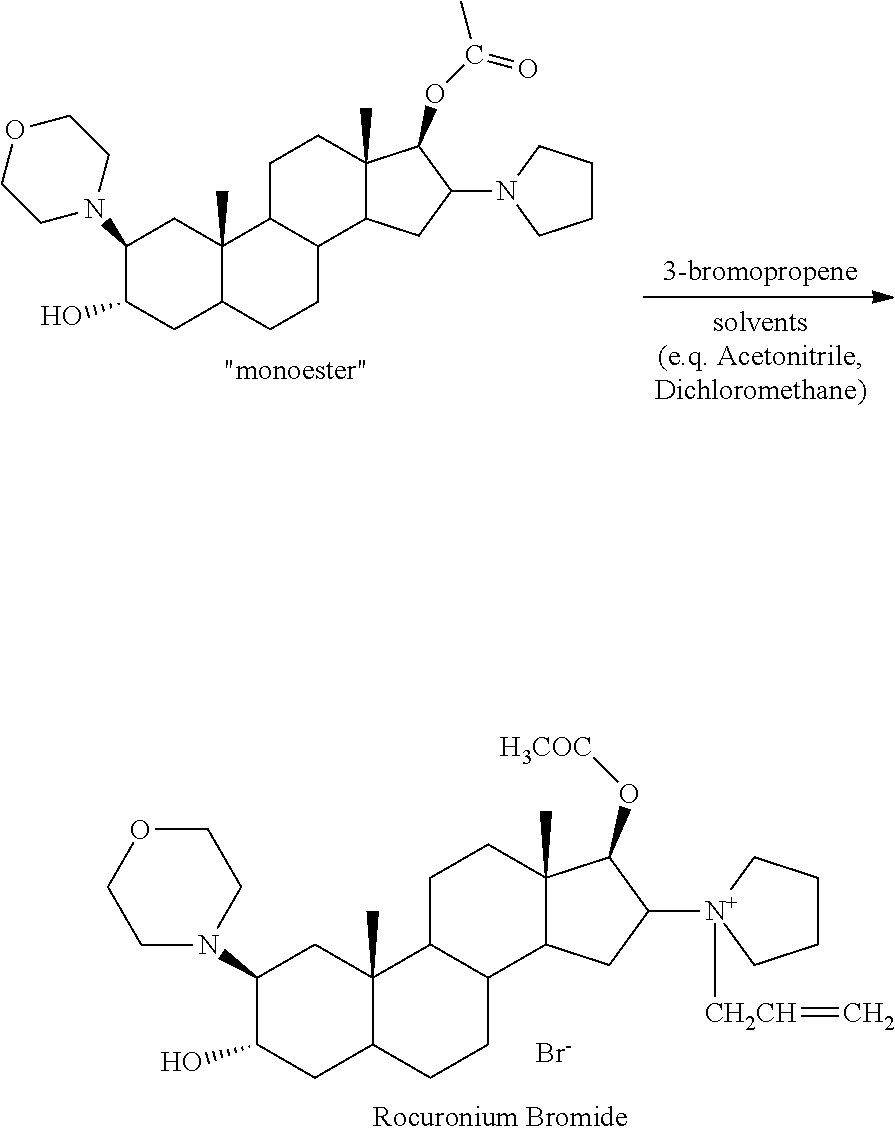Method for purifying crude rocuronium bromide
a technology of rocuronium bromide and purification method, which is applied in the field of medicine, can solve the problems of difficult solvents to leave the rocuronium molecule, difficulties in the industrial production of rocuronium bromide, and defects in existing production processes
- Summary
- Abstract
- Description
- Claims
- Application Information
AI Technical Summary
Benefits of technology
Problems solved by technology
Method used
Image
Examples
example 1
[0076]Preparation of crude rocuronium bromide: 500 g of rocuronium bromide intermediate monoester, 2.25 L of dichloromethane, and 600 mL of 3-bromopropene were mixed and stirred at room temperature for 16 hours. The reaction mixture was filtered and diluted with 1.75 L of dichloromethane, and was then mixed with 25 L of methyl tert-butyl ether while stirring vigorously, which gave a suspension containing a white precipitate. After the suspension was stirred for 20 minutes, the precipitate was filtered off, then re-dissolved with 3.5 L of dichloromethane, and added to 25 L of methyl tert-butyl ether under stirring. The precipitate was filtered off and washed with methyl tert-butyl ether to obtain crude rocuronium bromide.
[0077]Purifying of crude rocuronium bromide: firstly, the above crude rocuronium bromide was vacuumed in a vacuum oven for 3-5 hours, and then transferred to a 2 L single-necked flask. 680 mL of methanol, 100 mL of water and 30 mL of acetic acid were added to the fla...
example 2
[0079]Preparation of crude rocuronium bromide: 500 g of rocuronium bromide intermediate monoester, 2 L of acetonitrile and 600 mL of 3-bromopropene were mixed and stirred at room temperature for 8 hours. The reaction mixture was filtered and diluted with 2 L of dichloromethane, and was then mixed with 25 L of methyl tert-butyl ether while stirring vigorously, which gave a suspension containing a white precipitate. After the suspension was stirred for 20 minutes, the precipitate was filtered off, then re-dissolved with 3.5 L of dichloromethane, and added to 25 L of methyl tert-butyl ether under stirring. The precipitate was filtered off and washed with methyl tert-butyl ether to obtain crude rocuronium bromide.
[0080]Purifying of the crude rocuronium: firstly, the crude rocuronium bromide was vacuumed in a vacuum oven for 30 minutes, and then transferred to a 2 L single-necked flask. 560 mL of methanol was added to the flask. The solid was dissolved by bubbling with carbon dioxide gas...
example 3
[0083]Preparation of crude rocuronium bromide: 500 g of rocuronium bromide intermediate monoester, 2 L of acetonitrile and 600 mL of 3-bromopropene were mixed and stirred at room temperature for 8 hours. The reaction mixture was filtered and diluted with 2 L of dichloromethane, and was then mixed with 25 L of methyl tert-butyl ether while stirring vigorously, which gave a suspension containing a white precipitate. After the suspension was stirred for 20 minutes, the precipitate was filtered off, then re-dissolved with 3.5 L of dichloromethane, and added to 25 L of methyl tert-butyl ether under stirring. The precipitate was filtered off and washed with methyl tert-butyl ether to obtain a crude rocuronium bromide.
[0084]Purifying of the crude rocuronium: the crude rocuronium bromide was added to a 2 L single-necked flask. A mixture of 480 mL of methanol and 100 mL of water was added to the flask. The solid was dissolved by bubbling with carbon dioxide gas and stirring to form a homogen...
PUM
| Property | Measurement | Unit |
|---|---|---|
| temperature | aaaaa | aaaaa |
| temperature | aaaaa | aaaaa |
| temperature | aaaaa | aaaaa |
Abstract
Description
Claims
Application Information
 Login to View More
Login to View More - R&D
- Intellectual Property
- Life Sciences
- Materials
- Tech Scout
- Unparalleled Data Quality
- Higher Quality Content
- 60% Fewer Hallucinations
Browse by: Latest US Patents, China's latest patents, Technical Efficacy Thesaurus, Application Domain, Technology Topic, Popular Technical Reports.
© 2025 PatSnap. All rights reserved.Legal|Privacy policy|Modern Slavery Act Transparency Statement|Sitemap|About US| Contact US: help@patsnap.com

